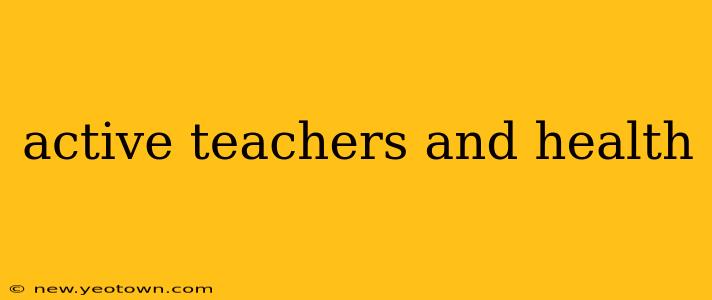Active Teachers: The Heartbeat of Healthy Schools and Thriving Students
The image of a teacher often conjures up someone hunched over papers, grading late into the night. But a growing body of research highlights a different picture: the active teacher, a vital force in fostering not only academic success but also the overall well-being of students and the school community. This isn't just about physical activity; it's about a dynamic approach to teaching that embraces movement, engagement, and a holistic view of student health. Let's explore what makes an active teacher and how this approach benefits everyone involved.
My name is Emily Carter, and I've spent the last 15 years as an educator and researcher focused on the intersection of physical activity and academic performance. I've seen firsthand the transformative impact of active teaching methods.
What Does an "Active Teacher" Really Mean?
An active teacher isn't just someone who incorporates a few stretches into the classroom. It's a multifaceted approach encompassing several key elements:
-
Physically Active Teaching Strategies: This includes using movement-based activities during lessons, encouraging breaks with light exercises, and creating a classroom environment that encourages physical engagement. Think brain breaks with jumping jacks, incorporating movement into math problems (e.g., measuring distances), or using active games to reinforce learning concepts.
-
Mentally and Emotionally Active Engagement: This means fostering a classroom environment where students feel safe to express themselves, ask questions, and participate actively in discussions. An active teacher creates a space for collaboration, critical thinking, and emotional well-being. This can involve mindfulness exercises, encouraging open communication, and providing a supportive and inclusive learning environment.
-
Active Participation in School Community: An active teacher is involved beyond the classroom walls. They participate in school events, collaborate with other teachers, and contribute to the overall well-being of the school community. This fosters a sense of unity and shared purpose.
How Does Active Teaching Benefit Students' Health?
The advantages are manifold:
-
Improved Physical Health: Increased physical activity during the school day combats childhood obesity and promotes healthy habits.
-
Enhanced Cognitive Function: Movement boosts blood flow to the brain, improving focus, attention, and memory. Studies show a direct link between physical activity and academic performance.
-
Reduced Stress and Anxiety: Physical activity is a natural stress reliever, and a supportive classroom environment further reduces anxiety levels in students.
-
Better Social-Emotional Development: Active teaching methods encourage teamwork, cooperation, and communication, fostering positive social-emotional development.
What are the Challenges of Implementing Active Teaching?
H2: What are the biggest challenges teachers face when trying to incorporate more movement into their classrooms?
The biggest hurdles are often time constraints, lack of resources, and concerns about classroom management. Many teachers feel pressured to cover a vast curriculum within limited time, making it difficult to incorporate physical activity. Lack of designated space or appropriate equipment can also be a barrier. Concerns about managing a more active classroom and maintaining order are valid but can be addressed with proper planning and training.
H2: How can schools support teachers in becoming more active in the classroom?
Schools play a crucial role in supporting active teaching. This includes providing professional development opportunities focusing on active teaching strategies and classroom management techniques for active learning environments. Schools should also invest in resources like appropriate equipment and designated spaces for movement-based activities.
H2: How can teachers incorporate active learning into subjects like math and science?
Active learning isn’t limited to PE. In math, students can measure distances, build shapes, or use movement to represent mathematical concepts. In science, experiments can involve hands-on activities and movement. For example, students can act out the water cycle or build models of the solar system, incorporating physical movement into the learning process.
H2: Are there any resources available to help teachers implement active teaching strategies?
Numerous online resources offer lesson plans, strategies, and best practices for active teaching. Organizations dedicated to physical education and health education also provide valuable support and materials. Search for "active learning strategies" or "movement-based learning" to find a wealth of resources.
The Future of Active Teaching
Active teaching is not a fleeting trend; it's a paradigm shift towards a more holistic and effective approach to education. By prioritizing the well-being of both teachers and students, we create a learning environment that fosters not only academic achievement but also lifelong health and happiness. The active teacher is the key to unlocking a brighter future for our students.

